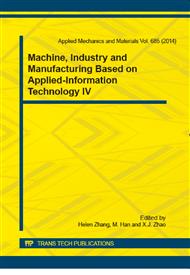p.195
p.199
p.204
p.208
p.212
p.217
p.224
p.228
p.232
Reliability Analysis of Y-Ring Rod Seal on the Servo Turret
Abstract:
From the perspective of stress and heat distribution, the influence of material and heat on working reliability of the turret seal is analysed. Based on the actual working condition of a servo turret, the FEA (finite element analysis) of structural mechanics and thermal structural coupling is carried out on the key reciprocating seal between piston and oil cylinder. The analysis re that material hardness and temperature have great influence on the seal contact pressure and the leakage. To be specific, the lower seal material hardness leads to the lower maximum contact stress and longer seal’s service life without increasing the net leakage under 3.5 Mpa oil pressure. The result demonstrates that the material with hardness 90 is better than that with hardness 95 under the hydraulic pressure 3.5Mpa. Besides, temperature distribution of seal under the working condition is gained through the thermal structural coupling analysis. It is concluded that increasing temperature lead to decreased leakage and enhanced contact stress. Consequently, the influence of the temperature should be taken into consideration on the research of seal numerical model.
Info:
Periodical:
Pages:
212-216
Citation:
Online since:
October 2014
Keywords:
Price:
Сopyright:
© 2014 Trans Tech Publications Ltd. All Rights Reserved
Share:
Citation:


